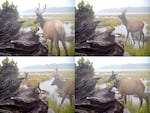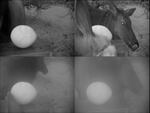While thinking about new places to take her practice, Portland-based artist Malia Jensen's mind turned toward the wild places where so many Oregonians seek solace.
“I really had been wanting to take my work out of the box of a gallery space, the expected location where we think we go to see art,” Jensen said.
What better, she thought, than to be led by the animal life that’s fascinated her since her days growing up outside Willamina, Oregon? At the same time, she wanted to address the digital culture consuming human interactions.
“I’ve been thinking about the internet as an evolutionary malfunction, a glitch that we're struggling to adapt to,” she said.

Artist Malia Jensen's "Nearer Nature" project utilized 18 motion-triggered field cameras to gather images of wildlife.
Courtesy of Malia Jensen
Jensen sees us letting go of the alliances we traditionally forge with disparate people from our work and home circles, random neighbors, and turning instead to screens.
“Your phone won’t save you when the shit really hits the fan. I still like to ask people for directions and favorite lunch spots,” Jensen said. "And it’s not always about being lost or hungry.”
This was both ethos and method for her latest project, Nearer Nature: Worth Your Salt. She sought funding from the Oregon Community Foundation’s Creative Heights initiative, a fund intended for innovative works of arts and culture.
Related: Malia Jensen's Homeward Journey
Jensen's concept is undoubtedly an exercise in thinking bigger. Elaborating on ideas from her 2011 series, "Salty," she sculpted human body parts out of high-density salt licks, and positioned them in six wild places around the state: a head in Portland's West Hills, a pile of doughnuts representing a stomach in Central Oregon, a foot in Wallowa County. Together, they sketch the rough outline of a human form reclining across the state. All these sculptures were under surveillance by 18 motion sensitive trail cameras.
“The process of finding locations [for] the cameras was really interesting: honing my own tracking abilities, finding the scat, finding the multiple trails, looking for broken branches.” She wanted different kinds of light in different shots, for morning or evening, and even infrared shots collected overnight.
“There were all these multiple considerations,” Jensen said.
Oregon’s wildlife took it from there, as a diverse array of creatures — elk and deer, but also bears, woodrats, cottontails, and a vast array of birds — paraded past the lens.
“I love the irony and humor of using unwitting animals as diplomats and salt sculptures of human body parts as conduits for exchanges,” Jensen said. “In human and animal bodies, salt functions in a vaguely parallel way, enabling connections in our blood and muscles.”
Further, she liked the symbiotic structure of her relationship with her subjects: Animals get salt their diets need, while the artist gets a series of images certain to hold human attention.

Artist Malia Jensen created "Nearer Nature: Worth Your Salt" with help from the Oregon Community Foundation's Creative Heights grant.
Courtesy of Malia Jensen
Ben Mercer, Jensen’s editor for the project, explained: “Malia would leave three cameras at each location and check them once a month, and in that time, it would accrue as many as 900 sequential clips.”
In some of the clips, elk come up to the salt sculpture, squeaking and bugling to each other, right on the edge of human habitation. In other clips, Jensen caught animal interactions most people will never see in places like Lower Nehalem Community Trust land, and back country in Wallowa County, near the LH residency headquarters.
"When you're watching it, it has a very contemplative and meditative quality," Mercer said.
Over six months, Jensen compiled more than 25,000 video clips, each 30 seconds to a minute long. With help from a team of assistant editors, Jensen, and Mercer organized the clips in a grid formation, with four contiguous clips playing simultaneously.
So what to do with all this amazing video? For Jensen, the setting for playing back the finished work was equally important as the images themselves.
She selected places as diverse as her capture points for the clips, mindful of locations different kinds of people would use together: the Riverside restaurant in Maupin, and Manzanita's San Dune Pub, as well as a chocolae shop in Joseph, a mental health clinic in Enterprise, KSMOCA at an elementary school in Portland, a feed store in Redmond and one tiny, 100-year-old grocery store in Tygh Valley.
The very placement of the screens felt fundamental, something to take viewers somewhat unaware. At one site, the Skyline Tavern on the heavily-wooded edge of Forest Park, Jensen’s video loop is tucked in between Keno screens.
Scott Becker, owner of the Skyline and himself a filmmaker, quipped, “We culture jammed [the screen] for the next few months.” He gestured at the herd of elk on the screen, noting it was collected just down the hill from the Skyline, on private land maintained under a conservation easement.
“I just love it. These are our other neighbors,” Becker said.
On a barstool, an ex-welder named Scott Bently looked on as Jensen’s loop cycled through images of deer and elk meandering through a mildly-spooky black and white infrared clip. Bently, who works nights so he can spend daylight hours in the woods, agreed there’s a divide in how people view nature, and maybe by extension, each other.
“I think a lot of people new to the area are amazed to see a deer in the yard," he said. "Some people, who’ve been here a long time are just trying to keep them out of their garden — you moved into their back yard. They didn’t move into yours!”
Jensen’s hope is that viewers from different walks of life, whether hikers or hunters, farmers or others, might fall under the video’s spell long enough to stop what they’re doing, talk with other viewers and truly listen to each other.

Some images gathered at night for Malia Jensen's project, "Nearer Nature: Worth Your Salt", provided intimate - not to mention slightly spooky - views of wildlife.
Courtesy of Malia Jensen
“This project isn't about me or my art,” Jensen said. “It’s about bringing a literal network back to the earth after having thrown our relationships up to the internet, to network face-to-face. Whatever people talk about as they watch the video is great. I’m not trying to be in that conversation.”
These chance encounters are what Jensen thrives on. In fact, it was an unexpected meeting with a molecular biologist in Wasco County that led to one of “Nearer Nature’s” installations. On a siting trip through Tygh Valley, Jensen was on a rancher friend’s land when she happened on a private fly-fishing party on the White River.
“As it turned out,” she said, “they were a group of doctors and scientists from OHSU.” And among their numbers was Dr. Susan Hayflick, a medical geneticist, and chair of the department of molecular genetics at OHSU.
“We noticed a person in a white van,” Hayflick remembered, “walking back and forth past her, we struck up a conversation. She came and spent the evening with us. We were mutually intrigued with each other.”
Related: The Album Art Of Tokio Aoyama
Hayflick, an avid outdoorswoman, was so taken with the project she offered Jensen space for one of her video installations on a monitor outside her lab’s office.
“We work in such a technical, synthetic environment here, I liked the idea of contrasting that — or calming it — with art,” she said.
While it’s not the most heavily-trafficked part of the OHSU campus, Hayflick said the installation quickly became a draw.
“It’s really compelling. It’s hard for me to walk away from it. There’s always something coming next I haven’t seen. I see other people stopping, even if it’s only a half a minute," she said. "It’s starting to be a topic of conversation: ‘Did you see the coyote family?’”
Hayflick sees science and art as intimately tied together, in ways that echo throughout “Nearer Nature.”
“We see the beauty of the molecules we work on, their power in causing or relieving disease. It’s a continuum of those elements to the macro elements of the elk wandering through the forest.”
If you come across one of Jensen’s video feeds between now and December, watch a while and maybe strike up a conversation with someone else watching.
“We have to build alliances with people whose opinions differ from our own, and create a society from our common humanity and not the extremes we’re being pushed to,” Jensen said. “To untangle difference from animosity and be compassionate with each other … it takes actual work.”
"Nearer Nature: Worth Your Salt", is on view at 12 sites across Oregon through Dec. 2.
